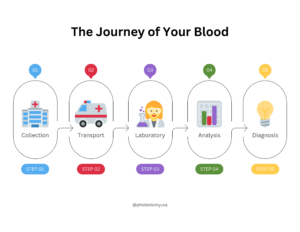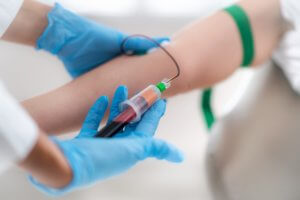19 Dec Where Does Your Blood Go After It’s Drawn?
Have you ever wondered what happens to your blood after it’s drawn at the doctor’s office? From there, it starts an unseen journey that takes multiple steps. Each step in this journey is essential for reaching the right diagnosis for your health. Let’s explore this path from the moment of collection to the final diagnosis.
Step 1: Collection
The first stop is with a phlebotomist, a blood collection specialist. They ensure that the blood draw is both safe and accurate. The quality of the blood sample is very important because it greatly impacts your test results. The phlebotomist’s role is to ensure the sample starts its journey in the best possible condition.
Step 2: Transportation
After your blood is collected, it needs to be sent to a laboratory. This step is all about maintaining the quality of the sample. As a result, transporters must handle the blood carefully and keep it at the right temperature. This ensures that when it arrives at the lab, it’s in perfect condition for testing. Think of this as a carefully orchestrated relay race where the baton – your blood sample – must be passed precisely.
Step 3: The Laboratory
Upon arrival at the lab, your sample enters a new phase of its journey. It’s distributed to different specialized departments, each playing a role in uncovering health information. Generally, your blood will not go to each area. Where it is sent depends on your ailment. Regardless, each department is very important to the health world:
Chemistry Department
Here, technicians look for specific chemicals in your blood. They can find signs of various conditions, such as high sugar levels. This may indicate diabetes or the presence of harmful substances.
Hematology Department
This department focuses on the blood itself, counting types of cells and measuring protein levels. Their findings are crucial for diagnosing conditions like anemia or identifying clotting disorders.
Immunology and Molecular Diagnostics
Experts here delve into your immune system and examine your genes. This helps in spotting autoimmune disorders and understanding predispositions to certain diseases.
Virology Department
This area identifies viruses and understands your body’s response. It’s particularly important for diagnosing infections like the flu or conditions like HIV.
Transfusion Services
For those needing transfusions, this department ensures the donated blood is safe and matches the patient’s ABO type.
Step 4: Analysis
Specialists in each of these departments use advanced techniques to analyze the samples. This is when the blood gives up its secrets. The tests can reveal everything from specific pathogens attacking the body to abnormalities in blood cells. Each test adds an important piece to the overall health puzzle.
 Step 5: Diagnosis
Step 5: Diagnosis
At this point, the lab gathers the results and sends them to your doctor. This is crucial, as your healthcare provider uses the information to diagnose your condition and create a treatment plan. It’s where the insights gained from your blood test turn into medical advice.
Conclusion
In sum, each time you have a blood test, it’s part of a detailed and crucial process. Though invisible to you, this journey is fundamental to achieving the right diagnosis and treatment. It tells a silent but vital story about your health, assisting your doctor in making informed decisions for your care. Understanding this journey can give you a greater appreciation for blood tests’ vital role in improving your health.

